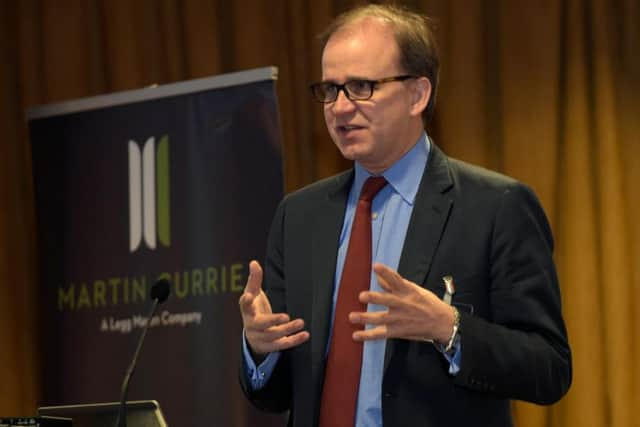The Scotsman's Market Conference: How attractive is Asia?
That was the view of Andrew Graham, head of Asia for Martin Currie, who said he had visited a large number of UK wealth managers over recent weeks and found they only had 5 to 6 per cent of their funds invested in Asian markets.
Graham posed the question “should we keep existing funds in Asia and should we put more into Asia?” – and provided evidence to deliver an emphatic yes.
Advertisement
Hide AdAdvertisement
Hide AdAsian markets are delivering growth three times that of the developed world and that is predicted to continue – and valuations are “reasonable and attractive relative to the rest of the world”.


Asia, excluding Japan, has 20-year annualised growth of 10 per cent and this is predicted to remain at a similar level (9 per cent) to 2020.
Graham noted four key drivers of economic growth in Asia:
Increasing consumption driven by rising wealth and consumer spending;
A wide range of world-class tech companies;


Infrastructure growth driven largely by increasing urbanisation;
Increasing inter-regional trade, which has benefited from the reduction and removal of tariffs.
“Asia’s biggest trading partner is now itself,” said Graham.
“The middle class has grown substantially and is still growing – and this is where the action happens in terms of consumption.”


[In the next 20 years, 88 per cent of 1 billion people entering the global middle class will be from Asia].
Advertisement
Hide AdAdvertisement
Hide AdMuch consumer spending growth in Asia is happening online, through portals like China’s massive e-commerce business, Alibaba, now with a market cap of $500bn-plus.
Alibaba has helped turn China’s Singles Day into an online trading phenomenon, worth more than $25bn alone on 11 November, 2017.
By comparison, just under $5bn was spent on Thanksgiving/Black Friday in the United States last November.


China has not yet made it into the index of the world’s most innovative countries but this will change.
China filed 1.34 million patents in 2016 (the last year when figures are available), way ahead of second-placed US with just over 600,000.
Far more STEM graduates are coming out of China than anywhere else – China has 4.6m STEM graduates, with 2.6m in India and 568,000 in the US.
In addition, the percentage of digitally active people using fintech services is very high in Asia, driven by a high level of digital “first interactions” with financial services in Asia.
Graham stressed that the rapid growth leading to investment opportunities was not limited to China and India.
Advertisement
Hide AdAdvertisement
Hide AdHe highlighted the Association of South East Asian Nations (ASEAN) – dominated by Indonesia, Malaysia, Philippines, Singapore and Thailand – which has formed an effective 10-country trade bloc and is now the world’s sixth largest economy with 8 per cent of the global population.
“ASEAN is often overlooked, but it has made strong progress and worked hard to reduce trade barriers,” he said.
“It has now eliminated tariffs on 90 per cent of traded goods with China.”
However, market indices have failed to match economic growth in Asia – International Monetary Fund (IMF) world economic outlook figures show 10-year annualised GDP growth in Asia (excluding Japan) of 9 per cent to the end of 2017, against market growth of just 4 per cent.
Graham said there had been poor capital allocations to these markets, but added: “Past performance is not a guide to future returns and attractive valuations enhance the investment case.”
He outlines Martin Currie’s unconstrained approach to investment in his article on this page.
Comment: Capturing the growth momentum is possible, says Andrew Graham
Asia remains the growth locomotive of the world, having delivered over three times the rate of real gross domestic product (GDP) expansion of G7 leading economies over the last 20 years.
Advertisement
Hide AdAdvertisement
Hide AdThis year, the International Monetary Fund (IMF) forecasts the region’s most populous countries, China and India, to expand by 6.6 and 7.4 per cent respectively – with growth rates in the United Sates and UK at 2.7 and 1.5 per cent.
Many economists, including at the IMF, believe this growth advantage will be maintained for some time.
Indeed, the region’s economies enjoy a raft of strong tailwinds (see main article).
Asia’s growth momentum is supported by the region’s emphatic embrace of technology.
Economies such as South Korea, home of global giant Samsung Electronics, and Singapore continue to feature at the top of international innovation rankings.
Although it may not rank as highly, China is making speedy progress thanks to a supportive government, increasingly skilled labour pool and fast growth of patent applications.
Of course, strong trends offer little excitement for investors if markets are already pricing them in.
On many valuation measures, Asian stock markets are trading in line with long-term averages but, importantly, they are priced at a significant discount to other key markets such as the US (looking increasingly expensive against history).
Advertisement
Hide AdAdvertisement
Hide AdThis is despite a strong earnings’ (and now revenue) recovery in Asia, not to mention record cash balances on company balance sheets.
In fact, Asia is priced more keenly than many markets, even though a large number of its businesses generate similar or better performance on metrics such as return on equity (ROE).
Stockmarket performance can diverge significantly from GDP growth.
Over the past 10 years, the market (MSCI AC Asia Pacific excluding Japan) has grown by an annualised 4 per cent, significantly slower than Asia ex Japan’s nominal GDP (9 per cent on average).
Asian businesses vary greatly in their ability to harness this growth, and a disciplined process, examining the quality of each individual business is therefore essential.
We believe an actively-managed approach is the best way to capture the Asian growth opportunity. In fact, Martin Currie Asia Unconstrained Trust aims to do just that, by targeting nominal GDP growth rather than a regional market-based benchmark.
As long-term investors we set the bar very high, because we know from experience that well-managed companies with strong governance and sound financials, offer the best chances of sustainable value creation.
Our investment specialists search high and low for these types of businesses and conduct detailed analysis to ensure the portfolio consists only of the ideas where we have the highest conviction.
Andrew Graham is head of Asia, Martin Currie
Advertisement
Hide AdAdvertisement
Hide AdComment: Sentiment comes into the reckoning, says Caspar Rock
Historically, the riskiest time to own equities is not during a recession, but as economies go into a slowdown phase that can precede a recession.
When you think about this, it is understandable – a slower economy will lead to a downgrade in earnings and a market that is no longer prepared to pay such a high multiple for a lower level of earnings growth. Hence a double hit to valuations.
At Cazenove Capital, we are business cycle investors, continuously monitoring markets for any signs of a slowdown in growth, which are currently few and far between.
The UK economy may still feel like it has left the handbrake on, but the rest of the global economy is currently pretty vibrant – the United States is spurred on by the Trump tax cuts, Europe and Japan show clear signs of a good old-fashioned cyclical recovery, while in emerging markets and Asia there are both cyclical and secular reasons for growth.
While inflationary pressures are picking up, we are not worried they will rise to levels that would precipitate more rapid rate rises from central banks.
This gives a backdrop for continued strong economic growth.
At this current point in a market cycle, positioning and sentiment become more influential to market behaviour.
After an extended period of rising asset prices, asset holders generally have a rather positive, although perhaps not yet euphoric outlook, while valuations compared to longer-term trends cannot be described as cheap.
Advertisement
Hide AdAdvertisement
Hide AdThe biggest risks to our outlook are threefold: firstly, growth disappoints; secondly, rising interest rates and the reversal of quantitative easing unsettles the current equilibrium in the markets; and thirdly, government intervention changes the competitive dynamic, whether it be tariffs on international trade or tighter regulation of, for example, the technology sector.
To that end, we are neutral on equity, which is a less positive stance than most of our peers, and hold a clear preference for overseas equities compared to UK equities. Within fixed income, we have a preference for inflation-linked rather than conventional securities.
Caspar Rock is chief investment officer, Cazenove Capital